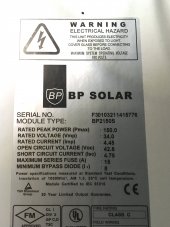cedarshoot
New Member
- Joined
- Oct 9, 2021
- Messages
- 7
Hi longtime lurker but new user on forum.
I have been watching WP's videos since he was in his RV and I've been using his book for my small builds.
I have been combing the forum for answers to my questions but have not been able to find every detail.
I am embarking on a new off grid system based on a single Tesla S module.
I am aware that this is not an ideal battery, but It was given to me and I would like to work with it as a learning experience.
I am also aware of the dangers of this module so I have l been tiptoeing up to this build.
I currently have the module set up with an eVZero tap board and a balance meter which shows the module has perfect balance and voltage.
I also have acquired some panels very cheap so my system is kind of a tail wagging the dog approach, so here goes.
I would like to run 6s panels array which are BP Solar 2150S :
PMAX 150
VMP 34.0
Voc 42.8
Imp 4.45
-I am hoping to use an EPEVR MPPT 40A SCC on this system per WP's first (and only) Tesla battery build in the RV days, (because of its programmable features), and the panels are used but test pretty strong (41v) , so I'm wondering about being over current for this SCC @ 6S array.
-I have yet to identify the best BMS board for this solo battery and would like suggestions, hoping to stay away from the EV boards which seem overkill.
-I am unsure about inverters, as some say their 24v models will go to a lower voltage to best utilize this battery, but also am wary and want to stay to over 30% SOC, but it's kind of chicken/egg until I have the BMS.
Since I'm OK getting what I get from this system, I'm not after a certain KW capacity, just want to get the best results from my panels and battery and stay safe.
THANKS!!
I have been watching WP's videos since he was in his RV and I've been using his book for my small builds.
I have been combing the forum for answers to my questions but have not been able to find every detail.
I am embarking on a new off grid system based on a single Tesla S module.
I am aware that this is not an ideal battery, but It was given to me and I would like to work with it as a learning experience.
I am also aware of the dangers of this module so I have l been tiptoeing up to this build.
I currently have the module set up with an eVZero tap board and a balance meter which shows the module has perfect balance and voltage.
I also have acquired some panels very cheap so my system is kind of a tail wagging the dog approach, so here goes.
I would like to run 6s panels array which are BP Solar 2150S :
PMAX 150
VMP 34.0
Voc 42.8
Imp 4.45
-I am hoping to use an EPEVR MPPT 40A SCC on this system per WP's first (and only) Tesla battery build in the RV days, (because of its programmable features), and the panels are used but test pretty strong (41v) , so I'm wondering about being over current for this SCC @ 6S array.
-I have yet to identify the best BMS board for this solo battery and would like suggestions, hoping to stay away from the EV boards which seem overkill.
-I am unsure about inverters, as some say their 24v models will go to a lower voltage to best utilize this battery, but also am wary and want to stay to over 30% SOC, but it's kind of chicken/egg until I have the BMS.
Since I'm OK getting what I get from this system, I'm not after a certain KW capacity, just want to get the best results from my panels and battery and stay safe.
THANKS!!



